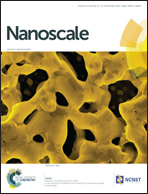Continuous and ultrathin platinum films on graphene using atomic layer deposition: a combined computational and experimental study†
Abstract
Integrating metals and metal oxides with graphene is key in utilizing its extraordinary material properties that are ideal for nanoelectronic and catalyst applications. Atomic layer deposition (ALD) has become a key technique for depositing ultrathin, conformal metal(oxide) films. ALD of metal(oxide) films on graphene, however, remains a genuine challenge due to the chemical inertness of graphene. In this study we address this issue by combining first-principles density functional theory (DFT) simulations with ALD experiments. The focus is on the Pt ALD on graphene, as this hybrid system is very promising for solar and fuel cells, hydrogen technologies, microreactors, and sensors. Here we elucidate the surface reactions underpinning the nucleation stage of Pt ALD on pristine, defective and functionalized graphenes. The employed reaction mechanism clearly depends on (a) the available surface groups on graphene, and (b) the ligands accompanying the metal centre in the precursor. DFT calculations also indicate that graphene oxide (GO) can afford a stronger adsorption of MeCpPtMe3, unlike Pt(acac)2, as compared to bare (non-functionalized) graphene, suggesting that GO monolayers are effective Pt ALD seed layers. Confirming the latter, we evince that wafer-scale, continuous Pt films can indeed be grown on GO monolayers using a thermal ALD process with MeCpPtMe3 and O2 gas. Besides, the current in-depth atomistic insights are of practical use for understanding similar ALD processes of other metals and metal oxides on graphene.



 Please wait while we load your content...
Please wait while we load your content...